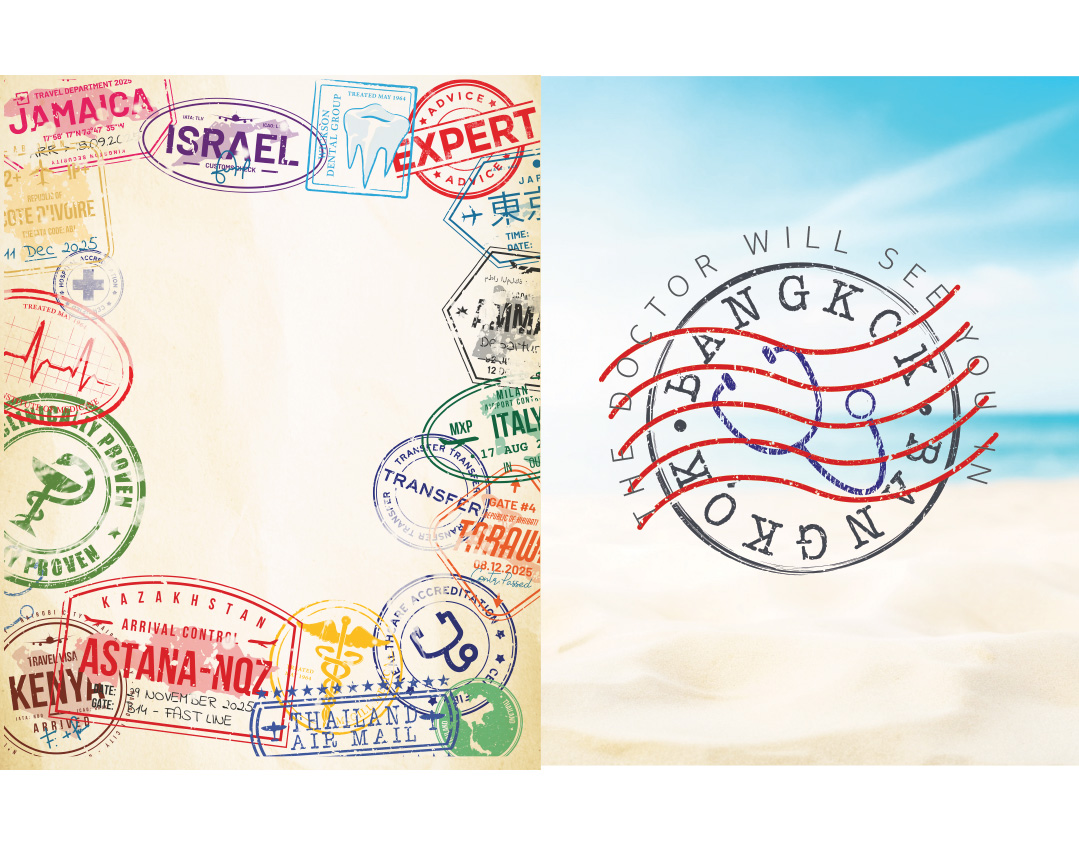The Doctor Will See You in Bangkok
| October 29, 2024How far would you travel to save on medical care?

A hip replacement in Thailand.
A dental surgery in Costa Rica.
Millions of people travel to foreign countries every year for procedures at a fraction of the price, or medical treatments not offered at home.
How far would you travel to save on medical care?
IT was 4:30 a.m. when the Uber pulled up in front of Frieda’s house. She and her husband Moshe were already outside, standing by the curb with their suitcases ready. After weeks of researching, packing, planning, and prepping, the couple was about to embark on a 22-hour flight to Bangkok, Thailand, with a three-hour stopover in Taiwan. What have I gotten myself into? Frieda thought.
“I’m the type of person whose idea of an exciting night is going to a Chinese auction to raise money for Bonei Olam,” Frieda says with a laugh. “I’m a 58-year-old grandmother who rarely travels outside Brooklyn. To say this was out of my comfort zone is a huge understatement.”
Frieda wasn’t going to Thailand to see the historic sites or pristine beaches. She was joining the 14 million people who travel for medical tourism every year. From the Bangkok airport, she would be heading straight to Bumrungrad International Hospital for a hip replacement.
When Frieda was in her 30s, she was diagnosed with arthritis, and it only got worse with age. “I couldn’t chase after my grandkids anymore. I couldn’t walk without pain. At 58, I felt I was too young to live like this. My doctor told me I needed a hip replacement, but my health insurance sent me a letter saying my claim had been denied, stating my condition wasn’t bad enough. I appealed and lost. The cost of paying for it myself in a New York hospital was around $50,000.”
Frieda and Moshe had some money saved, but they had set it aside to help pay for their grandchildren’s yeshivah tuition. “I know for a fact that for at least one of our children, our financial help is the reason they’re able to send their children to yeshivah. I was willing to be in pain for my grandchildren’s chinuch, but one day, as I was limping to shul, an acquaintance of mine asked me what was wrong. I told her my whole saga and she relayed that a friend of hers had gotten a total hip replacement at a hospital in Bangkok.”
Frieda was intrigued. She spoke to the woman, who had been very happy with her experience at Bumrungrad Hospital. The doctor who treated her had even done a fellowship in America. “I did some research online and found out that I could get the same hip replacement done for $25,000, including airfare and an Airbnb.”
Though Frieda was excited about the idea, her husband was not. “You want to get surgery in a third-world country when we have the best doctors in the world right here in New York?” he said to her.
“It’s the same procedure,” Frieda argued back, “for a fraction of the price. Everyone speaks English, most of the doctors have done part of their training overseas, and they’re one of the top medical tourism spots in Asia.”
Moshe realized that Frieda had done her research. “I looked into the orthopedist at the hospital I would be using. He had gone to medical school in Japan and had completed a surgery fellowship in the United States. I saw that Bumrungrad was one of the world’s best hospitals,” she says.
Frieda’s adult children begged her to have the procedure done in America. “One of them said they wouldn’t accept money for yeshivah tuition if I didn’t do the surgery here. I said, ‘I made my decision. I’m doing this.’ I was going to use the same doctor as the woman who’d had a good experience at Bumrungrad hospital, so I knew I’d be in good hands. Besides, supporting my grandchildren was more important to me than doing the surgery in America.”
Even though Frieda’s mind was made up, when she stepped onto the plane, she felt a wave of fear. “My mind was filled with what-ifs. What if I got an infection at the hospital? What if the surgery goes wrong? What if we get robbed in Thailand? I davened like it was Yom Kippur. ‘Please Hashem, watch over me and give me hatzlachah.’ ”
Flying Far to Save $$
Traveling to a different location for health reasons is an age-old practice. After the ancient Romans conquered England, they would travel to the hot springs in the city of Bath, believing that the waters there had special healing powers and could cure any number of illnesses, from anxiety to gout. Throughout the 19th century, people continued to go to Bath to “take the waters.”
When undergoing a medical procedure, there have always been people willing to travel to a renowned hospital or doctor, even if it’s in a different city, to get the best possible care. But a unique feature of the medical tourism of today is that millions of people are traveling from countries with a higher standard of health care to countries with a lower standard to save money. They might go to a country where the doctors don’t speak their language, or where they wouldn’t drink the water, because they can get procedures done at a price they can afford.
“Our market has always been what I call the ‘working poor,’ and they just keep getting poorer,” says Josef Woodman, chief executive of Patients Beyond Borders, speaking to the New York Times. “The pandemic has gutted low-income and middle-class people around the world and for many of them, the reality is that they have to travel to access affordable health care.”
Dr. Jason Yap, head of international health care marketing for Singapore, has seen an influx of American patients over the years. “When Americans come to Singapore, they generally come for specific issues — knee replacements, hip replacements, and certain kinds of cancer surgery. And in most cases, it’s because they can’t afford health care in the United States,” he told a Wall Street Journal reporter.
If you compare numbers, the differences in health care costs between the US and Singapore range from significant to staggering: “A knee replacement in America that would cost between $48,000 to $55,000 would cost $11,000 in Singapore,” Dr. Yap reported.
As president of Medical Tourism Training, a company that provides training and accreditation to international health travel organizations, Elizabeth Ziemba sees medical tourists travel for all sorts of reasons, but the number one reason is to save money. “We know that the US health care system is incredibly expensive,” she tells CNN. “Even for people with insurance, there may be high deductibles or out-of-pocket costs that are not covered by insurance, so that people will look based on price for what’s available in other destinations.”
Certain countries are hot spots for specific medical treatments. “With Mexico and Costa Rica, it’s overwhelmingly dental and cosmetic surgery. However, certain countries are known for specialties. For example, in Singapore, stem cell and oncology is huge. In India, South India and Chennai Apollo hospitals do incredible work with hip and knee surgeries,” Woodman told CNN. “In Eastern Europe, a lot of people from the UK — but also people from the United States — travel to Hungary, Croatia, and Turkey for everything from dental to light cosmetic surgery.”
The top destinations for medical tourists are Costa Rica, India, Israel, Malaysia, Mexico, Singapore, South Korea, Taiwan, and Thailand. But for Americans, Mexico is the most popular destination, with dentistry accounting for 55 percent of treatments.
“I Was Desperate”
Cheaper health care is the primary reason people cross borders, but there are other considerations, too. Sometimes people travel to avoid excessive wait times. In Canada, a backlog in surgery during the Coronavirus pandemic led people to get their procedures done in other countries to avoid the wait.
Spending less doesn’t always mean getting worse results. In Israel, IVF treatments are a fraction of the price with similar outcomes. People also travel to Israel for their groundbreaking medical advances. In the past decade alone, Israeli scientists have invented a device to correct scoliosis, pioneered new drugs to treat eczema, and created a tiny device that can make an artificial retina meld with the neurons in the eye, restoring sight to people whose retina has been damaged due to diseases such as macular degeneration and diabetic retinopathy.
An advantage of medical tourism is that you can access treatments that aren’t readily available in your own country, such as xenotransplantation — taking cells or tissues from animals and putting them in people. Or consider HCST, an intense chemotherapy treatment for Multiple Sclerosis that aims to reset the immune system by wiping it out and regrowing it, using your own stem cells.
“Why would I choose, against medical advice, to have HCST?” asks Miles on UK’s Multiple Sclerosis Society website. “In a nutshell, like so many people with MS, I was desperate.” Before treatment, Miles was using crutches to get around. His MS symptoms were getting worse every year and while HCST wasn’t illegal, it wasn’t readily available in the UK. In Mexico, a team of hematologists had opened a clinic in Monterrey, offering the treatment.
“All we had to do was find £46,000 [a little over $61,000]!” Miles relates. “Yes, one massive lump of money! Here, I was very lucky. We had some life savings and generous contributions from family, to whom I’ll be ever grateful.” Miles traveled to Monterrey, where he had to do four rounds of chemotherapy, and have his stem cells harvested, then frozen and reintroduced into his body.
While Miles was eager to do the procedure, traveling for stem cell treatment is a controversial practice. Stem cell tourism, “hurts the legitimacy of the entire field of stem cell science and medicine,” says Timothy A. Caulfield, the Canada Research Chair in Health, Law, and Policy at the University of Alberta, speaking at the Harvard Stem Cell Institute. He believes clinics offering stem cell treatments are guilty of “financially exploiting” desperate people, and people raising money to finance travel to these so-called clinics are “raising money to turn over to a fraud.”
Miles had a very bad reaction to his treatment. “I became one of the unlucky 15 percent of patients who develop an infection,” he recalls. “The clinical staff immediately put me on intravenous antibiotics for three days, which at first seemed to work, but on the fourth day my temperature skyrocketed.”
Miles was taken to an ER in a private hospital and given a private room and hooked up to antibiotics. “I was told that hospitalization was fairly rare, as most people respond to the initial batch of antibiotics.”
“I’m now back home,” Miles says, “and taking it very easy trying to recover from the huge impact the last month has had on my body. The big question is ‘did it work?’ Sorry to disappoint, but I don’t know and probably won’t know for at least a year, when comparative MRI scans will be able to show no disease activity or otherwise. I do feel I’ve taken some control over MS and until I know the result, I remain optimistic that I’m MS free.”
An Extraction in Costa Rica
Issy, a yeshivah bochur from Lakewood, became a medical tourist when he was 23 years old. “I was having pain in my back gums. It got so bad that I was chewing on ice chips all the time,” he says. “I’ve always hated going to the dentist, and I hadn’t been in years, but now I figured I had to go.”
He went to the dentist, who took one look in his mouth and said, “You need to see an oral surgeon. I think your wisdom teeth might be impacted.”
An oral surgeon in Lakewood did a panoramic X-ray and showed Issy his teeth on a screen. “You see your wisdom teeth? They’re growing sideways. They’re pressing against your other teeth. You’ve got to get them taken out.”
After the doctor left, Issy went to the front desk. “How much do I owe?”
“That’ll be $500 for today’s X-rays and consultation,” the lady told him.
“$500?” he asked. “You should give out laughing gas with the bill.”
She didn’t crack a smile. “Should we schedule your surgery now?”
“How much will that cost?”
“$8,000 to extract all four teeth.”
Issy didn’t have that kind of money, or any way to get it. “I had $2,000 in my bank account at the time,” he says with a laugh.
He did some research online and found that he could get it done in Costa Rica for $1,000, plus hotels and airfare. He convinced a buddy to join him for the trip. They decided to stay in Costa Rica for a week, do some sightseeing, and then do the oral surgery on the last day of the trip. “I told my parents that we were going on a trip to Costa Rica, but I didn’t tell them about the extraction because I knew they’d just worry.”
Issy stayed in a youth hostel with eight people in a room and one bathroom. “We met people around our age from all over the world. And there was plenty of packaged kosher food in the grocery stores. Seeing the rainforest left me awed by Hashem’s creation. There were monkeys playing in the trees and colorful parrots flying overhead. We swam at the bottom of a waterfall and went zip-lining under a canopy of trees.”
Though Issy was having a good time, in the back of his mind, he was worried about the upcoming extraction. “When the day of my procedure came, I had a terrible premonition that something would go wrong. I thought about calling the whole thing off.” But his wisdom teeth were still hurting him, and he had come all this way just to do this procedure. He decided there was no backing out now.
“The office was very nice, and looked like a regular dental office in America,” Issy remembers. “The only difference was a list of procedures and their prices hanging on the wall. The receptionist asked me to pay in cash before the procedure, and the hygienist kept trying to upsell me on other services they offer.
“ ‘One of your teeth is a little chipped,’ she told me. ‘We can fix that for $50. Your teeth are yellowing — you want us to whiten them for $300?’ She was weirdly aggressive. American doctors are more discreet when it comes to money. In the US, they make it sound like they just care about your health, and it’s only after they treat you that you get a big bill in the mail. In Costa Rica, they’re more transparent that they’re providing a service for cash, rather like a car mechanic.”
The doctor offered to put Issy under general anesthesia for the procedure, but that would cost an extra $500. He decided to do a local numbing shot and hope for the best. “It took around an hour, but I didn’t feel anything,” Issy says. “I thought, that really wasn’t so bad. I’m glad I didn’t splurge on the general anesthesia.”
The doctor said it went well. “I was told to leave a gauze pad over the area for 45 minutes, and then eat something cold like ice cream or yogurt. I was given pain medication, which I took sparingly. I had to eat soft foods and liquids. I was hungry the whole flight back.”
The problems started when Issy got home. “My lower lip and chin felt numb the next day, and the day after that as well. I was Googling the complications of wisdom tooth extraction and I saw that you can get nerve damage from the procedure. That got me really nervous. Maybe I should’ve waited until I saved up the money, or borrowed to pay the Lakewood surgeon. Maybe the guy in Costa Rica was a third-rate oral surgeon who had messed me up for life.”
He tried calling the doctor in Costa Rica, but they kept telling him he was seeing patients. He didn’t return his calls.
Issy called the oral surgeon in Lakewood and tried to make an appointment. “You should see the original doctor who did the surgery,” said the receptionist.
“But he’s not getting back to me!” Issy cried. The phone disconnected.
“A week passed by, and it wasn’t better,” Issy says. “I could poke my chin with a fork and feel nothing. Everything I saw online told me this wasn’t good. I was up half the night pacing, driving myself crazy. I’m so dumb, I told myself. Who goes to Costa Rica for dental work?
But then Issy had a change of heart. “I thought to myself, Ein od milvado. This too is from Hashem. I davened, gave tzedakah, and made a promise that I would learn a sefer on my own outside of yeshivah. Then I finally went to sleep.”
When Issy woke up, he thought he had a little more sensation in his lip and chin. “Every day after that, it got a little better and in another two weeks, I was back to myself,” Issy says with relief in his voice. “But I would never, ever travel to another country for medical work again. There’s just not enough accountability if something goes wrong.”
Dr. Sam Straus, an oral surgeon in Boro Park, Brooklyn, has seen many patients like Issy, who seek his care after traveling to doctors in other countries for dental work. “In the 80s and 90s, I would see a lot of older Europeans who had gone to Hungary and Romania for implants or wisdom teeth extraction. It was a lot cheaper, and they speak the language. Today, people go to Costa Rica and Israel.”
Some of the risks of wisdom tooth extraction are bleeding, swelling, dry socket (a painful condition where the blood clot covering the wound becomes dislodged or doesn’t fully form), and nerve damage (either temporary numbness in the lip, chin, and tongue, or permanent numbness). Dr. Straus stresses that it’s important to choose a doctor with skill and experience for the best possible outcome.
“I’m not saying that foreign doctors aren’t trained or experienced,” Dr. Straus emphasizes. “There are world-renowned doctors in other countries, but I can’t recommend medical tourism because while most patients might get away with it, the one percent come back with problems. The quality is sometimes questionable because the doctors know they won’t see that patient again. I’ve had patients come back having done major restorative work, and because it was done so poorly, I had to take it out and start from the beginning.”
One issue that Issy ran into when he came back to Lakewood is that the local oral surgeon didn’t want to see him. Dr. Straus explains why that might be the case: “No doctor wants to assume responsibility for someone else’s work. With any surgical procedure, the person who did the surgery knows your case best, but with a foreign provider you don’t have the option to go back to them.”
Dr. Straus thinks that someone considering medical tourism for dental work really needs to think about the risks versus the benefits. “My father always said, ‘the cheap person pays twice.’ If people do procedures in Israel where they have relatives and a place to stay, I can understand it. But if someone goes to Costa Rica where they must pay for flights, hotels, and the cost of treatment, do they really end up saving anything?”
Low Cost, High Risk
According to a study published in the New England Journal of Medicine, in 2023, 13 US residents came back with confirmed cases of fungal meningitis after traveling to a private cosmetic surgery clinic in Mexico. Nine died.
This wasn’t the first time there had been an outbreak among medical tourists. In October 2022, a woman from Colorado in her 30s went to a clinic in Baja, Mexico to receive embryonic stem cell injections in her spine to treat her multiple sclerosis. She developed headaches and fevers similar to meningitis. She was one of at least three people to go to Mexico to undergo stem cell injections and come back with mycobacterium abscessus, a deadly drug-resistant bacterial infection. Embryonic stem cell injections are not approved in the United States because they carry significant risk — injected cells can multiply into inappropriate cell types or even dangerous tumors.
“It’s hard to put an exact number, because unfortunately, nobody seems to be monitoring this very closely,” says Dr. Charles Daley, a pulmonologist at National Jewish Health, a hospital in Denver that treated patients returning with resistant bacteria. “There’s very little oversight.”
Many people are happy with the care they receive abroad. Horror stories stand out because they don’t happen every day, but medical tourism can be dangerous.
“There are the complexities of traveling if you have a medically complex situation. There are fit-to-fly rules. And your health care providers should take into consideration the impact of traveling if you have orthopedic injuries or issues,” Elizabeth Ziemba told CNN. “The quality of care may be an unknown…It may be that the quality of care is not up to the standards that you would like. So there’s a bit of an unknown there, and then the last thing I would say is, if something goes wrong, what’s going to happen?”
Travelers can pick up infectious diseases such as Hepatitis C, Hepatitis B, and HIV from substandard sterilization and cleanliness standards. There’s also a risk of getting a drug-resistant infection if the health care facility doesn’t have good infection control practices.
Dr. Nolan Perez is a gastroenterologist in Brownsville, Texas, which is across the border from Matamoros, Mexico. He commonly manages complications from medical tourism in his practice.
“There are a lot of bad outcomes. There are a lot of infections and a lot of botched procedures gone wrong, and patients have to come back to the United States and then have a revision of the surgery,” he tells CNN. “It’s really unfortunate.”
Even if you’ve received terrific care, flying soon after surgery could increase your risk of infection, blood clots, or dislocating new hip or knee replacements. That’s why, according to Dr. Yap, “the best place for medical surgery is near your home.”
Frieda’s Journey
After 22 hours in the air, Frieda’s flight landed in Thailand. On the taxi ride to the hospital, Frieda saw people riding bikes with chicken cages attached to their backs. “We definitely weren’t in Brooklyn anymore,” she laughs. “When we got to the hospital, I felt a lot better. It looked like a hotel — everything was clean and modern, and everyone was very nice and spoke English. Unlike an American hospital, I had to pay up front before the procedure, but I knew in advance that this was how things were done here.”
Frieda was given a hospital gown and the nurses reviewed the information with her. She met with the surgeon, and he told her the surgery would take around two hours.
“He was very knowledgeable, kind, and patient, and he took so much time to answer all my questions. Then I was wheeled into the operating room.”
Hours later, Frieda woke up groggy.
“Moshe was by my side, and he told me that the orthopedist said the surgery had been a success. I was taken to a beautiful private room to recover, and I was overseen by attentive nurses who couldn’t do enough for me. One of the nurses saw my Tehillim and asked, ‘What language is that?’
“ ‘It’s Hebrew,’ I told her.
“ ‘Oh! You’re from Israel?’
“ ‘No,’ I replied. ‘I’m Jewish.’
“ ‘Oh! We have a lot of respects for Jews in this country. We heard Jewish men treat their wife like a queen. Is that true?’
“I laughed, and said, ‘Ask me again when my husband’s not in the room.’ All the nurses were laughing and asking me if I have a son their age.”
After two nights in the hospital, Frieda moved into the Airbnb with Moshe, and they hired a nurse to stay with her 24/7.
“The Airbnb was ridiculously cheap, around $150 a week. It was a spacious apartment with a full kitchen, even if the windows didn’t let in a lot of light because there were so many big buildings around us. The nurse was very nice and very inexpensive. She had cared for Americans recovering from hip replacements before. Her English wasn’t the best, but she knew just what I needed without me having to say a word.”
Moshe bought eggs and vegetables at the market every day.
“We tried exotic vegetables we had never eaten before,” Frieda says. “One day Moshe was craving some protein, so he bought a whole fish from a fish market. He had checked it himself for fins and scales, and confirmed with his Rav that it was kosher to eat. Then he cut, cleaned, and cooked it himself in the Betty Crocker we had brought with us.”
The orthopedist had sternly warned Frieda not to fly for four to six weeks after the hip surgery. Flying too soon after surgery can cause deep vein thrombosis — a life-threatening condition. It can also cause the hip replacement to loosen and threaten the success of the surgery. Despite the risks, Frieda was determined to get home, so she ignored her doctor’s medical advice. Before her trip, she had booked her ticket home for two weeks after her surgery, and she managed to make it onto the plane.
“It was a horrible journey home,” Frieda relates. “I was in extreme agony the whole flight. Getting jostled around in that cramped seat was brutal on my sore body. I was taking pain killers like Tic Tacs. I was terrified of getting a deep vein thrombosis because the doctor had really scared me about it. But I wasn’t going to spend a month in Bangkok. It would be fine for a gentile, but a Jew needs a minyan, kosher meat, a shul. I had to get back to Brooklyn. I wore compression socks, took a blood thinner and hoped for the best.”
When Frieda made it back to Brooklyn, she was in for a long recovery. “I needed a lot of pain medication, and months of physical therapy, but when it was all over, I was able to take my grandkids to the park again. My hip felt great. I felt it was worth it.”
Frieda doesn’t normally share her story with others.
“There’s a lot of judgement when you tell people that you did a surgery in another country,” Frieda says. “I learned to keep it to myself. When I went to my orthopedist for a follow-up, he chewed me out: ‘You took a 22-hour flight a week after your surgery? Do you know how dangerous that is? I don’t know what kind of doctor you went to or if he even was a real doctor. Hopefully, you don’t pick up an infection.’
“ ‘I feel fine,’ I told him.
“ ‘Even if it’s working now, don’t be surprised if dislocates or loosens in the future. You get what you pay for.’ ”
Frieda’s hip replacement took place two years ago and so far, it’s held up. It’s supposed to last ten to 15 years.
But would she recommend it to others?
“Only if you do your research and you have a lot of koach,” Frieda says laughing. “It’s definitely not for the faint of heart.”
(Originally featured in Family First, Issue 916)
Oops! We could not locate your form.







